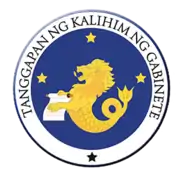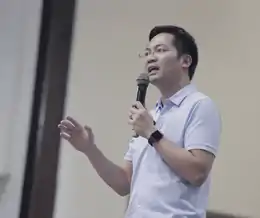Cabinet Secretariat of the Philippines
The Cabinet Secretariat, formerly the Office of the Cabinet Secretary (Filipino: Tanggapan ng Kalihim ng Gabinete), is a member agency of the Cabinet of the Philippines which provides support to the President, facilitates the exchange of information, as well as discussing and resolving issues among Cabinet members. The Cabinet Secretary also acts as a coordinator and integrator of the initiatives of the President.[1] The Cabinet Secretariat was created through Executive Order No. 237, s. 1987.[2]
| Cabinet Secretary
Kalihim ng Gabinete | |
|---|---|
 | |
| Style | The Honorable |
| Appointer | The President |
| Term length | At the President's pleasure |
| Formation | December 22, 1986 |
| Kalihiman ng Gabinete | |
 Seal as the Office of the Cabinet Secretary | |
| Cabinet overview | |
|---|---|
| Formed | 22 December 1986 |
| Cabinet executive | |
History
The position of Cabinet Secretary traces its origins to the War Cabinet of the Commonwealth government-in-exile, when Col. Manuel Nieto was appointed Secretary to the Cabinet by President Manuel L. Quezon in Asheville, NC.[3] Under President Carlos P. Garcia, a Cabinet Secretariat was formally established as an attached agency of the Executive Office headed by the Executive Secretary. Under the administration of President Ferdinand Marcos, its responsibilities were transferred to the Office of the Prime Minister.
Following the People Power Revolution, the Cabinet Secretariat was reestablished through Executive Order No. 237, s. 1987 signed by President Corazon Aquino. It was renamed as the Office of the Cabinet Secretary by President Benigno Aquino III on October 31, 2012 through Executive Order No. 99. He reinstated the Office of the Cabinet Secretary as an independent body from the Presidential Management Staff, similar to its original mandate in 1987. The Cabinet Secretary was given cabinet ranking and staff support.[3]
The office underwent a reform in 2018, when President Rodrigo Duterte issued Executive Order No. 67, which transferred eight agencies under it to other government agencies and renamed it back as the Cabinet Secretariat.[4]
Powers and Functions
According to Section 2 of Executive Order No. 99, the powers and functions of the Office of the Cabinet Secretary are as follows:[1]
Sec. 2. Powers and Functions
a. Facilitate the identification of a list of priority areas and outcome-based targets in the Social Contract and PDP 2011-2016, in consultation with the Cabinet Clusters, for final approval of the President;
b. Recommend to the President an annual detailed and measurable performance and projects roadmap that will facilitate outputs of the targets against priorities, in close coordination with the concerned agencies;
c. Ensure the timely execution and monitor the significant impact of the targets under the annual performance and projects roadmap, and re-align targets when needed;
d. Represent the President in meetings and such other fora in order to expedite inter-agency action towards the achievement of the targets identified in the performance and projects roadmap;
e. Assist in providing timely and organized information to the Cabinet on issues and problems submitted for decision and action; andf. Perform such other functions as may be necessary and incidental to the attainment of its objectives or as may be assigned by the President.
Reorganization
Eight agencies under the Cabinet Secretariat was placed under the jurisdiction of other agencies when President Rodrigo Duterte reorganized the office. The Technical Education and Skills Development Authority (TESDA) and the Cooperative Development Authority was placed under the Department of Trade and Industry; the National Commission on Muslim Filipinos and the Philippine Commission on Women to the Department of the Interior and Local Government (DILG); the National Anti-Poverty Commission, the National Commission on Indigenous Peoples and the Presidential Commission on the Urban Poor to the Department of Social Welfare and Development (DSWD).[4]
List of Cabinet Secretaries
| Name | Term started | Term ended | President | Era |
|---|---|---|---|---|
| 1986 | 1992 | Corazon Aquino[5] | Fifth Republic | |
| Ma. Leonora Vasquez-de Jesus | 1992 | 1998 | Fidel V. Ramos[6] | |
| 1998 | 2001 | Joseph Estrada[7] | ||
| Ricardo Saludo | 2001 | 2004 | Gloria Macapagal-Arroyo[8] | |
| Silvestre H. Bello III | 2001 | 2010 | ||
| Jose Rene Almendras | 2012 | 2016 | Benigno Aquino III[9] | |
| Leoncio Evasco Jr. | 2016 | 2018 | Rodrigo Duterte[10] | |
| Karlo Nograles | 2018 | Incumbent |
References
- "Executive Order No. 99, s. 2012". Official Gazette of the Republic of the Philippines. 31 October 2012. Archived from the original on 13 January 2018.
- "Executive Order No. 237, s. 1987". Official Gazette of the Republic of the Philippines. 22 July 1987. Archived from the original on 31 January 2021. Retrieved 31 January 2021.
- "The Cabinet Secretary". Official Gazette of the Republic of the Philippines. Archived from the original on 29 September 2017. Retrieved 31 January 2021.
- "Duterte revives Cabinet Secretariat; removes 8 agencies under its supervision". UNTV News and Rescue. 1 November 2018. Retrieved 1 November 2018.
- "Corazon C. Aquino - Presidential Museum and Library". Archived from the original on 4 November 2012. Retrieved 27 October 2012.
- "Fidel V. Ramos - Presidential Museum and Library". Archived from the original on 23 March 2016. Retrieved 27 October 2012.
- "Joseph Ejercito Estrada - Presidential Museum and Library". Retrieved 27 October 2012.
- "Gloria Macapagal-Arroyo - Presidential Museum and Library". Archived from the original on 4 November 2012. Retrieved 27 October 2012.
- "Benigno S. Aquino III - Presidential Museum and Library". Archived from the original on 4 November 2012. Retrieved 27 October 2012.
- Ranada, P. (16 May 2016). "Medialdea is executive secretary, Panela is spokesman". Rappler. Retrieved 30 June 2016.
External links
- The Cabinet Secretary – Official Gazette of the Republic of the Philippines
